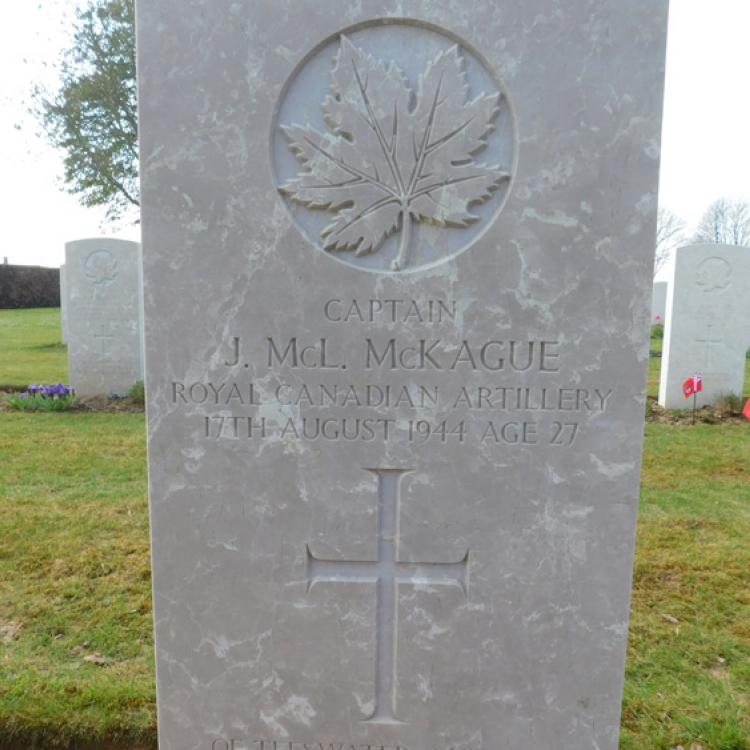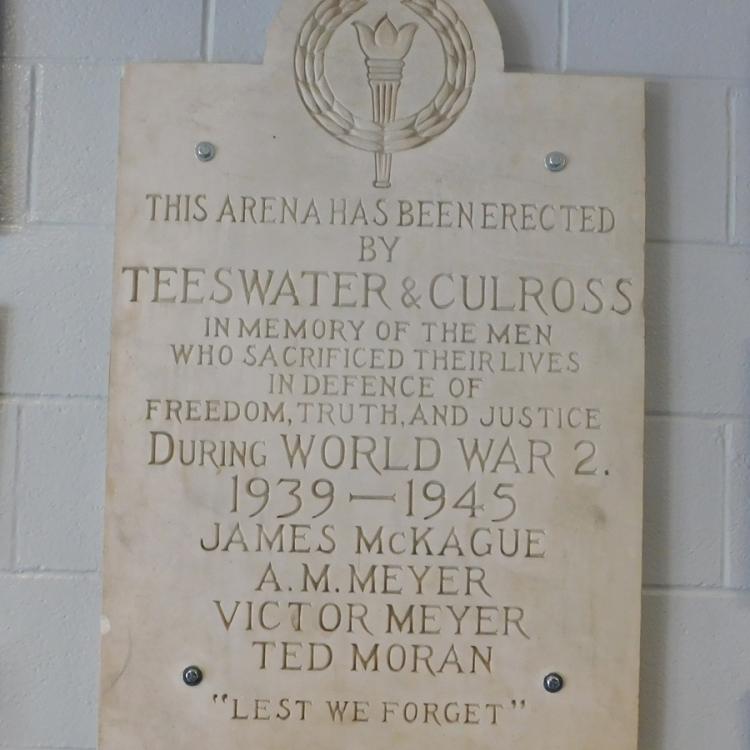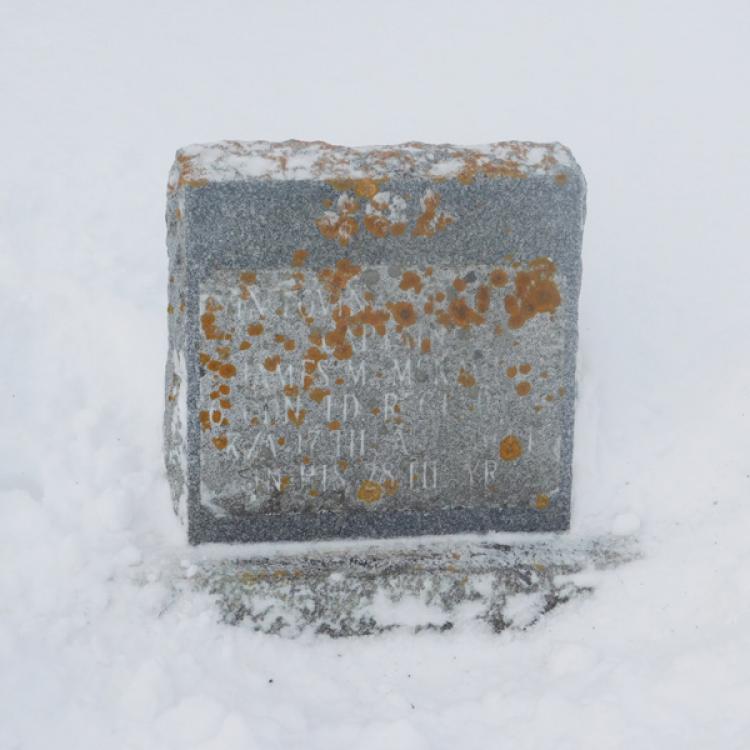McKAGUE, James McLean
not on Lucknow stone, removed reference
NAME McKAGUE James McLean
RANK Captain 1st Canadian Army - No. 2 Army Group of Royal Canadian Artillery REGIMENT 19th Army Field Regiment
“everywhere”
Royal Canadian Artillery Born August 4, 1917 - Teeswater - Township of Culross - County of Bruce Residence Wingham - Ontario Died August 17, 1941 27 years
Cemetery Bretteville-Sur-Laize Canadian War Cemetery - Cintheaus - Calvados - France
XXIII F 3
Parents Mr. Andrew and Jeannie McKague - Teeswater.
James was born at R.R. 1 Teeswater on August 4, 1917. He took his primary schooling in the Teeswater area and then took his high school education in Wingham District High School, graduated at age 21. He then enrolled at the Ontario Veterinary College in Guelph which was then affiliated with the University of Toronto. He graduated in 1939 with a Bachelor of Veterinary Science and in effect he was a Doctor of Veterinary Medicine. The family would have attended Knox Presbyterian Church and while he was in Wingham he would have attended St Andrews Presbyterian Church in Wingham. His classmates said of him.....Whose finger on the door bell of Macdonald "Mac" Hall has many times thrilled a maiden's heart. Whos geniality, sportsmanship and generosity, has won him many friends? Jim, we predict for you a large general practice, a host of friends and a brunette. Upon becoming a veterinarian, Jim then moved to Wingham and was employed as a veterinarian and this is where he earned his living up until the time of his enlistment. He was on the nominal roll of the 21st Field Regiment – Royal Canadian Artillery - 99th Battery. During 1941, he did his officer training at the Brockville Military Academy.
In Canada
James went to London on September 8, 1941 and enlisted into the Canadian Army and Taken on Strength at No. 1 District Depot. At the time he was 5' 10" and weighed 152 pounds. He had a fair complexion with blue eyes and fair hair. He was appointed Private and the same day appointed to the rank of Sergeant. He was now on appointment to the 99th Field Battery Royal Canadian Artillery. He was also On Command to the Officer Training Centre in Brockville - Ontario. On September 26 he returns from Brockville and ceases to be On Command. On September 27 he is appointed 2nd Lieutenant. He is on attachment to Camp Petawawa to the Royal Canadian Artillery Centre on October 3 and the next day he is attached to the Canadian Artillery Training Centre. On October 6 he becomes qualified in the use of a pistol. On December 1 2nd Lieutenant McKague qualifies of a Driver IC of both wheeled vehicles and motorcycles as well. He is appointed to rank of Lieutenant on December 4. On December 10 he is Taken on Service with the 19th Army Field Artillery Royal Canadian Artillery. On December 13th he was admitted into hospital with Laryngitis and was discharged on December 18th and one day later he was confirmed as a driver of 1/c truck Class III. Training continued into 1942 and in the summer on August 10 Lieutenant McKague is attached to the Winnipeg Grenadiers. On February 6, 1943 he received his 2nd class Bren Gun certificate. Between February 18 and March 12 he a patient at Kingston General hospital because of appendicitis. April 12, 1943 he is posted to Camp Barrfield to the Royal Canadian Ordnance Corps Training Centre. On May 31 he received his 1st class rifle certificate.
Overseas
Lieutenant McKague was Struck off Service of the Canadian Army in Canada on July 19 and the same day he embarked from Canada for duty overseas. The following day while at sea he is Taken on Service with the Canadian Army overseas. He disembarked in the United Kingdom on July 28. On August 16 he is assigned to No. 3 Canadian Armoured Corps Reinforcement Unit "E" Group. He then took a course on the operation of wheeled vehicles and tank operations. While on course he qualifies as a driver of a 1/c truck. In addition he qualifies as a tank driver. His knowledge, practical ability, driving, maintenance, and conduct while on the tank course was good. His driving time was 3 hours while his maintenance hours were 79. On September 4th he ceases to be attached to Canadian Armoured Corps Reinforcement Unit. On September 5th he returned from his course. Between September 7-16 he was on privilege leave with meal allowance. He returned from tank Equipment course and now ceases to be attached to 3 Canadian Armoured Corps Reinforcement Unit. Between October 24-30 he was on course to Canadian Signals Reinforcement Unit. On November 2nd he qualified as a driver of motorcycles.
In the Field
On June 1st, the 19th Field Artillery Regimen t in preparation for the upcoming landings on the continent boarded their landing craft and on June 6th, 1944 they landed on Juno Beach. While the regiment did their training in England they trained with the self propelled Sexton gun but at some point received the M7 Priest gun which was equipped with the M101 (105mm) howitzer gun that fired a large projectile at a lower velocity and higher trajectory. These guns were mounted on chassis and were self propelled. The M7 Priest also had a machine gun and had a crew of 8 men. Its weight was 50,000 pounds and had a speed of between 15-25 mph depending on the terrain. The armour was between 1/2" to 2 1/2" thick. The gun could fire a shell 7 miles. On D Day the 19th Army Field Regiment was part of the First Canadian Army Troops / No. 2 Army Group Royal Canadian Artillery / 14th Canadian Field Regiment Artillery Group. The Priests were strapped to landing crafts as they headed for the beaches and the waves were extreme because of the poor weather but even so at a range of 9,000 yards or 5 miles the Priest began firing onto enemy positions. Accuracy was poor because of the weather and each Priest over a 30 minute period fired between 100-150 rounds. There was minimal damage to the enemy positions as they had walls that were 3 to 7 feet thick. During D Day the 19th Field Regiment was in support of the 8th Canadian Infantry Brigade which landed at Bernieres-sur-Mer and they had 24 M7 Priests. At the close of June 6th, the 19th Artillery Regiment was positioned at St Aubin-sur-Mer which was Nan Red sector and during the day they had moved 2 1/2 miles eastward down the coast. One Priest was damaged when it hit a mine and lost a track. On this day 3 men were killed and 18 men were wounded. In July of 1944, the First Canadian Army became operational with the 2nd & 3rd Canadian Infantry Divisions plus the 4th Canadian Armoured Division. Also included was a Polish Division, a British Corps and at times Belgium, Dutch and American forces. On August 13, 1944 he was promoted to the rank of Captain. Captain McKague was then transferred to the 6th Field Regiment of Canadian artillery who then fought their way toward Falaise and the Falaise Gap. The regiment was now part of the 2nd Canadian Infantry Division, 6th Infantry Brigade and would support the Brigade in the push to the east. The 2nd Canadian Corps of the First Canadian Army was tasked with capturing Falaise and the first attack was to take part at night using armoured personnel carriers to move the infantry along with tanks and self propelled guns to spearhead and then follow the assault. The initial attack went forward just prior to midnight of August 7th, and this was preceded by heavy air bombardments, created by red and green flares fired from the artillery. There was initial success, as the first enemy lines were overrun including the village of Verrieres. During the month of July many Canadians fell here in the battle for Verrieres Ridge. Then, facing stiff enemy resistance along with Allied bombing errors that infliced casualties onto the Canadians, the momentum could not be maintained. The Germans at this point were being pushed eastwards and were becoming desperate as they tried to reach the River Seine. The enemy knew the Allies were trying to seal them in the gap. It was now time for a second assault by the Canadians onto Falaise. The tactics to be used were similar to the first attack except the attack would take place in the daylight. Smoke screens, artillery and Allied bombings were used and again there were errors in the bombings with more casualties being inflicted onto the Canadians. On August 16th, the 6th Field Regiment was located at Potigny and at 5:45 am reconnaissance parties were sent out and then at 11 am the Regiment moved to a position south of Villers-Canivet and at this time began firing in support of the 6th Infantry Brigade moving on Falaise. The firing continued until dark. Falaise was taken by the Canadians on this day. During the battle of Falaise and the Falaise Gap enemy losses were 10,000 men killed and 50,000 becoming prisoners of war. In addition, the enemy lost many hundred of tanks, guns of all types and vehicles. Even so it is estimated that many tens of thousands of German troops did reach the River Seine and they would fight a defensive fight through the eastern parts of France, Belgium, the Netherlands and into Germany itself. The next day, August 17th, Captain McTague and two others were killed when their carrier struck a mine.
In the artillery, the fire control has to be flawless. The communications between the Forward Observation
Officer and the guns had to be maintained in order for the Field Observation Officer to respond to the requirements of the infantry for fire support. The procedures and drills for controlling artillery fire had to be known by the armour and the infantry in the event the Field Observation Officer were to be killed or wounded. The infantry had to keep open the line of communication between the company and the battalion headquarters if the Field Observation Officer could not. For the infantry that was advancing, communications became less of a priority as they pressed forward their attack while under heavy enemy fire. An additional problem was the infantry losing their radio control, because now the line of communications is broken and loss of control begins to happen. Timely fire support includes the maintenance of such support while the armour and infantry moves rapidly forward in a highly mobile offensive operation meaning that the procedures for moving the guns to keep the armour and infantry in their range must be followed.
Captain McKague was originally buried in a churchyard in the area of Falaise before being laid to rest at Cintheaux. At Bretteville sur Laize Canadian War Cemetery, Captain McKague rests with 2,792 fellow Canadian comrades who fell in the later stages of the Battle of Normandy. The men resting here are from the 2nd Canadian Corps and represent every unit in the Corps.
Near the end of December around Christmas of 1944 his mother received the Memorial Cross. Mrs. McKague received the 1939-45 Star; the Europe + German Star; the Defence Medal; the War Medal and the Canadian Volunteer Service Medal in October of 1949.
Captain McKague is honoured and remembered on a plaque that is located in the Teeswater Arena. He is also honoured and remembered in the Culross Teeswater Cemetery. He is honoured and remembered on the wingham High School Memorial Plaque and on both the Teeswater and Wingham Cenotaphs. He is honoured and remembered in the Bruce County Museumand on the Canadian Virtual War Memorial. He is honoured and remembered in the Books of Remembrance found in thje Centre Hall of the Canadian Parliament. He is also honoured and remembered in Ottawa's National Artillery Monument situated on Green Island.




